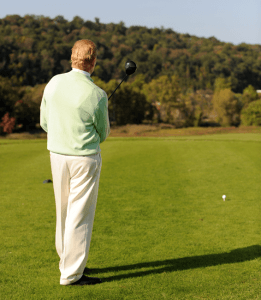Golf and Breathing

By Dr. T. J. Tomasi, Keiser University College of Golf Senior Faculty and Director of Research
You can bank on this: you will not play your best golf if you are trip-wire tense. I recommend that a deep breath be a part of every shot you hit in golf except the “gimmee.”
In a good pre-shot routine, your breath-to-relax comes after you make your shot plan. And correct breathing has another considerable upside. Dr. Van Wagoner of the Mayo Clinic says:
“Biofeedback affects the balance of nerve activity that in turn affects the heart. Sympathetic nerve activity (“fight or flight”) and parasympathetic activity (relaxation) are in a dynamic balance. But parasympathetic activity tends to decrease with aging, stress, and loss of conditioning, leading to increased heart rate and a reduction in heart rate variability.”
So, learning to breathe correctly aids you in making a good image of your next shot. Over time, it can help activate your relaxation response by stimulating your parasympathetic system.
How Good Are You at Breathing?
Under stress, many people breathe high in their upper chest, an inefficient technique that promotes a shallow inhale with rapid breaths. In the extreme, this causes hyperventilation, a dangerous condition with a poor exchange between carbon dioxide and oxygen.
Contrary to popular belief, your cells, not your lungs, regulate the rate of breathing. Tissue cells closely monitor the level of potentially dangerous carbon dioxide and are sensitive to the slightest increase or decrease. Thus, when carbon dioxide levels drop, your breathing slows and, under some conditions, can stop entirely. Mouth-to-mouth resuscitation works on this principle: to start a person breathing again, you blow your carbon dioxide into the other person’s system. With the rising carbon dioxide levels, your cells signal the brain to increase your breathing rate. When you breathe too quickly under stress, you exhale too much carbon dioxide creating an oxygen-carbon dioxide imbalance that can cause several uncomfortable symptoms, including sweating, nervousness, tingling of the extremities, dizziness, anxiety, and even panic attacks — none of which are helpful to your golf game.

Once you are positioned behind the ball, make a plan and then take a relaxing breath to improve your execution of the shot. See my book, The Thirty Second Swing, for details.
If you’d like to study with Dr. Tomasi and other PGA Master Professionals, contact The College of Golf today.














